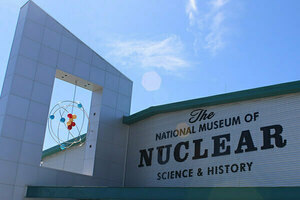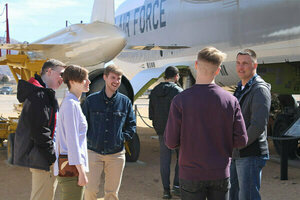Seven thousand feet above sea level, elevated above the deserts of New Mexico, there once was little more than a population of Pueblo Native Americans, a small group of homesteaders, and a boys’ school. That all changed during World War II.

In 1943, German scientists discovered nuclear fission, which found that atoms could be split to create energy. President Franklin Roosevelt appointed then-Colonel Wesley Groves (who was subsequently promoted to the rank of General) to lead a military operation known as the Manhattan Project. As a military mind, Groves recruited J. Robert Oppenheimer to lead the scientific side of the project, but they would need a place to conduct their experiments. Oppenheimer recalled the place of his family’s homestead—a place called Los Alamos. Being a remote site so high above sea level meant that observers could see anyone coming hundreds of miles away; it was the ideal location, and so the Los Alamos National Laboratory (LANL) was established.
Oppenheimer’s vision, which became the mission of the laboratory is:
There must be no barriers for freedom of inquiry. There is no place for dogma in science. The scientist is free, and must be free, to ask any question, to doubt any assertion, to seek for any evidence, to correct any errors.

LANL, which is just northwest of Santa Fe, and Sandia National Laboratories in Albuquerque were the centerpieces of The Notre Dame International Security Center’s (NDISC) Spring Break 2022 learning experience.
During the trip, NDISC students had the opportunity to listen to a series of fascinating briefings about the history, development, and use of nuclear weapons and advanced technologies like radiation-hardened electronics at the Microsystems Engineering Science and Applications Facility (MESA) at Kirtland Air Force Base, a facility so sterile, the number of dust particles in each room must be measured: a single piece of dust can block a function of a chip or cut a thin wire.
One conversation NDISC students and faculty listened to that particularly resonated was presented by Dan Summers, a Senior Mentor at Sandia and nuclear safety expert. During his talk, Summers discussed the history of nuclear safety and the systems that have been put in place over time to make sure the US’ nuclear arsenal is properly maintained and safe from an accidental deployment. At the end of World War II, with the dropping of Little Boy and Fat Man over Japan, the bombs’ charges were removed until they were ready to be deployed, but as the world entered the Cold War, more sophisticated safety mechanisms were needed to prevent an accidental detonation. The goal was to develop an enhanced nuclear safety program—achieving a one-in-a-billion standard of safety. “For the political scientists in the room,” Summers said, “We have the safest stockpile in the world. This is how we do it.”

“Nuclear weapons are a tremendously awesome system,” Summers said at the lunch following his presentation, “Their care and feeding requires constant vigilance to ensure safety. And I hope to God we never need to use them. I spent 53 years working on these, but I hope to God we never need to use them.”
Also, while at Kirtland Air Force Base, NDISC students had the opportunity to visit a Category III Nuclear Facility simply known as Tech Area V, where Project Leader David Lee taught us about the passive and active delay mechanisms the government uses to keep nuclear materials safe from bad actors. Additionally, students had the opportunity to take a first-hand look at a nuclear reactor.
The Notre Dame International Security Center offers its students the opportunity to visit and experience the most important places in the global community, both stateside and abroad. Want to find out where NDISC’s next adventure takes you? Get in touch with us today!
Originally published by at ndisc.nd.edu on April 15, 2022.